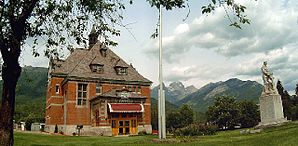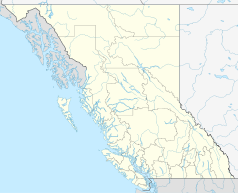Fernie (British Columbia)
| Fernie | ||
|---|---|---|
 The courthouse in Fernie |
||
| Location in British Columbia | ||
|
|
||
| State : |
|
|
| Province : | British Columbia | |
| Regional District : | East Kootenay | |
| Coordinates : | 49 ° 30 ′ N , 115 ° 4 ′ W | |
| Height : | 1001 m | |
| Area : | 14.83 km² | |
| Residents : | 4448 (as of 2011) | |
| Population density : | 299.9 inhabitants / km² | |
| Time zone : | Mountain Time ( UTC − 7 ) | |
| Postal code : | V0B 1M0 - V0B 1M7 | |
| Foundation : | 1904 ( incorporated ) | |
| Mayor : | Mary Giuliano | |
| Climate diagram | ||||||||||||||||||||||||||||||||||||||||||||||||
|---|---|---|---|---|---|---|---|---|---|---|---|---|---|---|---|---|---|---|---|---|---|---|---|---|---|---|---|---|---|---|---|---|---|---|---|---|---|---|---|---|---|---|---|---|---|---|---|---|
| ||||||||||||||||||||||||||||||||||||||||||||||||
Fernie is a small town in southeastern British Columbia , Canada . The city is about 97 kilometers east of Cranbrook and is part of the Regional District of East Kootenay . Fernie is the largest city between Cranbrook and the Alberta border . It is also one of the oldest settlements in the region.
The small town lies on the Elk River and is surrounded by high mountains. West of the village is located on the edge of Mount Fernie Provincial Park , the 2,390 meter (7,841 foot) high Mount Fernie and north of the 2,788 meter (9,147 feet) high mountain Group Three Sisters . Since there are also high mountains on the opposite side of the valley, Fernie is completely surrounded by the mountains of the Border Ranges .
history
Originally the country was settled by the First Nation . The Kutenai lived and still live in the area around what is now Fernie . In their language, today's small town is called ¢ aqawuʔkǂuʔnam . This means something like city in narrow terrain .
The city got its current name during the discovery and settlement by Europeans at the end of the 19th century. The region remained relatively untouched until Michael Phillips of the Hudson's Bay Company explored the Crowsnest Pass in 1873 . However, this changed with the discovery of coal in the area. The discovery of coal also brought William Fernie, later namesake and main character in a local story, to the Elk River Valley. Coal mining began in the region as early as 1897 and the Canadian Pacific Railway reached the settlement in 1898 . And on August 1, 1989, a post office opened in Fernie.
However, the development of the city suffered a significant setback in 1904 and 1908 when many of the buildings burned down in two large fires. Only 35 houses survived the 1908 fire. The construction of the city was no longer made of wood, but many of the buildings were now made of bricks.
In the course of the following years, the population was to rise to around 6,000 before the Depression in the 1930s brought coal production to a near standstill. A complete closure of the coal mines could only be prevented with considerable government support. Coal production then recovered, partly because of the increasing steel production during the Second World War , but was nevertheless dependent on subsidies for a long time.
Demographics
The 2011 census showed the city had a population of 4,448. The city's population has increased by 5.5% compared to the 2006 census, which is below the average for the entire province of British Columbia, where the population also increased by 7.0%. With an average age of 39.9 years, the population here is younger than in the rest of the province, with 41.9 years.
education
Fernie is part of School District # 5 - Southeast Kootenay . There are various schools in the small town; an elementary school , a secondary school and a branch of the College of the Rockies .
politics
The city was granted local government on July 28, 1904 ( incorporated as Town ). Fernie was granted the status of a ( City ) on December 12, 1939.
Mayor of the municipality is Mary Giuliano. Together with six other citizens, it forms the council of the small town (council).
economy
One of the most important industries in Fernie is still the extraction of natural resources (coal mining). A large proportion of the employees also find their work here and in the corresponding branches of industry such as repair. Another large area of employment is the hotel and catering industry.
The median income of Fernie employees in 2005 was C $ 25,560, while at the same time the average for the entire province of British Columbia was only C $ 24,867. The income difference between men (38.859 C $) and women (16.148 C $) is relatively large in Fernie, which is also explained by the different pay in the respective main areas of employment (men = minnig and maintenance; women = hotel and catering trade).
traffic
The Crowsnest Highway ( Highway 3 ) runs through the city in an east-west direction and divides the small town into two parts. Also in an east-west direction, a Canadian Pacific Railway Fernie line passes on the southwestern outskirts. This route is very important for coal shipments to the west coast, mainly to the Roberts Bank Superport .
The city does not have its own airport, but can only be reached via the airports of the surrounding communities.
Web links
- Website of the city (Engl.)
- Fernie on britishcolumbia.com (Engl.)
Individual evidence
- ↑ Ktunaxa words. FirstVoices.com , accessed October 9, 2012 .
- ↑ History of Fernie. Fernie.com , accessed October 9, 2012 .
- ↑ Fernie Community Profile. Census 2011. Statistics Canada , September 7, 2012, accessed October 9, 2012 .
- ^ School of District # 5. School District # 5, accessed October 9, 2012 .
- ^ Origin Notes and History. Fernie. GeoBC , accessed October 9, 2012 .
- ^ City Council. City website, accessed October 9, 2012 .
- ↑ Fernie Community Facts. BCStats , accessed October 9, 2012 .
